engine FIAT FIORINO 2017 Owner handbook (in English)
[x] Cancel search | Manufacturer: FIAT, Model Year: 2017, Model line: FIORINO, Model: FIAT FIORINO 2017Pages: 272, PDF Size: 5.87 MB
Page 160 of 272
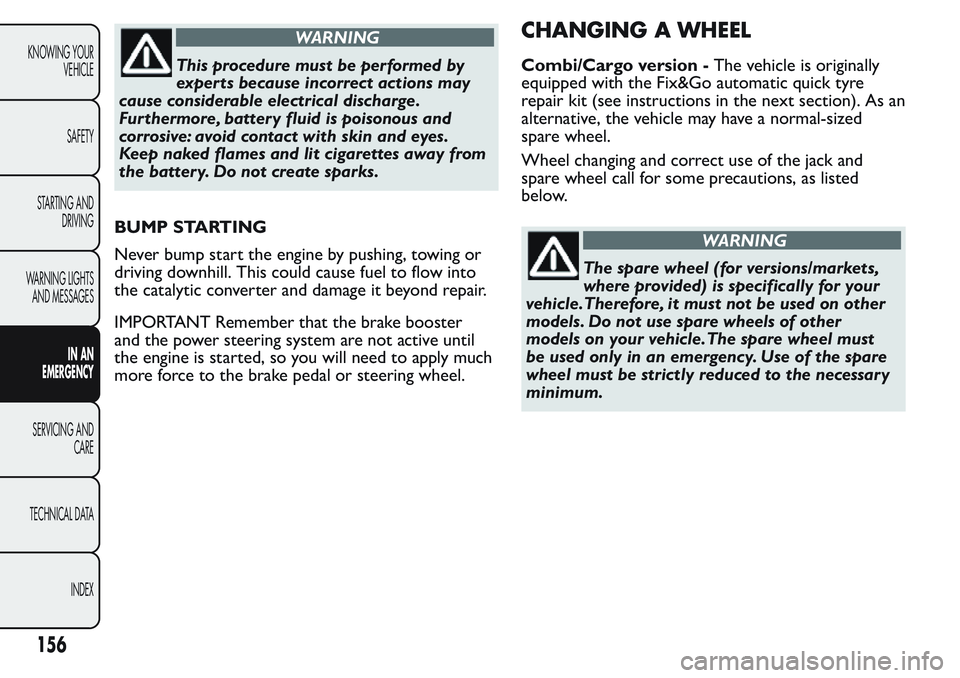
WARNING
This procedure must be performed by
experts because incorrect actions may
cause considerable electrical discharge.
Furthermore, battery fluid is poisonous and
corrosive: avoid contact with skin and eyes.
Keep naked flames and lit cigarettes away from
the battery. Do not create sparks.
BUMP STARTING
Never bump start the engine by pushing, towing or
driving downhill. This could cause fuel to flow into
the catalytic converter and damage it beyond repair.
IMPORTANT Remember that the brake booster
and the power steering system are not active until
the engine is started, so you will need to apply much
more force to the brake pedal or steering wheel.
CHANGING A WHEEL
Combi/Cargo version -The vehicle is originally
equipped with the Fix&Go automatic quick tyre
repair kit (see instructions in the next section). As an
alternative, the vehicle may have a normal-sized
spare wheel.
Wheel changing and correct use of the jack and
spare wheel call for some precautions, as listed
below.
WARNING
The spare wheel (for versions/markets,
where provided) is specifically for your
vehicle.Therefore, it must not be used on other
models. Do not use spare wheels of other
models on your vehicle.The spare wheel must
be used only in an emergency. Use of the spare
wheel must be strictly reduced to the necessary
minimum.
156
KNOWING YOUR
VEHICLE
SAFETY
STARTING AND
DRIVING
WARNING LIGHTS
AND MESSAGES
IN AN
EMERGENCY
SERVICING AND
CARE
TECHNICAL DATA
INDEX
Page 161 of 272
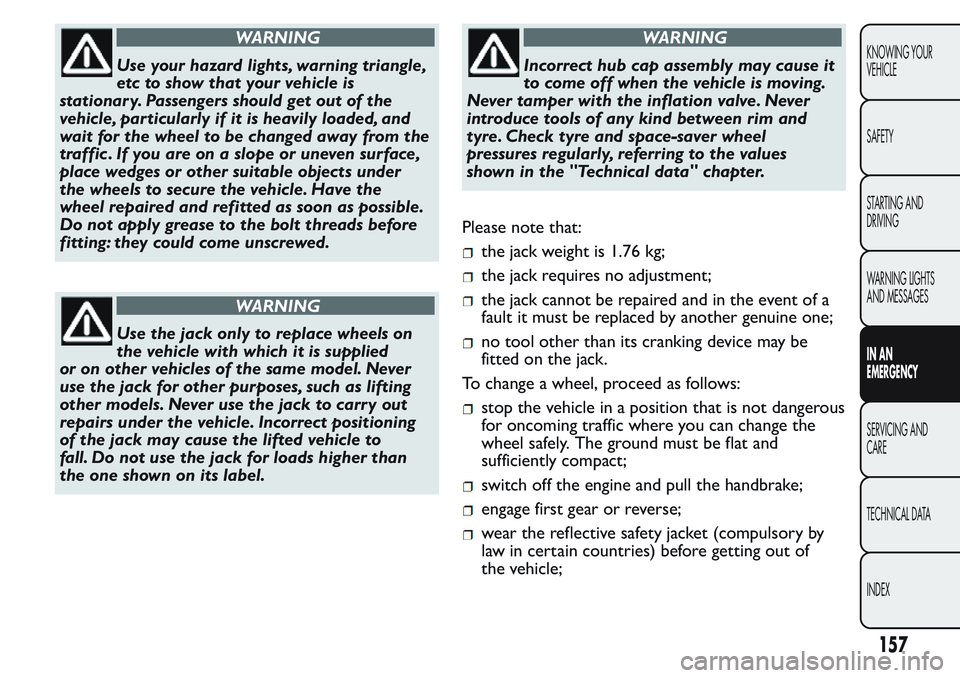
WARNING
Use your hazard lights, warning triangle,
etc to show that your vehicle is
stationar y. Passengers should get out of the
vehicle, particularly if it is heavily loaded, and
wait for the wheel to be changed away from the
traffic . If you are on a slope or uneven surface,
place wedges or other suitable objects under
the wheels to secure the vehicle. Have the
wheel repaired and refitted as soon as possible.
Do not apply grease to the bolt threads before
fitting: they could come unscrewed.
WARNING
Use the jack only to replace wheels on
the vehicle with which it is supplied
or on other vehicles of the same model. Never
use the jack for other purposes, such as lifting
other models. Never use the jack to carr y out
repairs under the vehicle. Incorrect positioning
of the jack may cause the lifted vehicle to
fall. Do not use the jack for loads higher than
the one shown on its label.
WARNING
Incorrect hub cap assembly may cause it
to come off when the vehicle is moving.
Never tamper with the inflation valve. Never
introduce tools of any kind between rim and
tyre. Check tyre and space-saver wheel
pressures regularly, referring to the values
shown in the "Technical data" chapter.
Please note that:
the jack weight is 1.76 kg;
the jack requires no adjustment;
the jack cannot be repaired and in the event of a
fault it must be replaced by another genuine one;
no tool other than its cranking device may be
fitted on the jack.
To change a wheel, proceed as follows:
stop the vehicle in a position that is not dangerous
for oncoming traffic where you can change the
wheel safely. The ground must be flat and
sufficiently compact;
switch off the engine and pull the handbrake;
engage first gear or reverse;
wear the reflective safety jacket (compulsory by
law in certain countries) before getting out of
the vehicle;
157
KNOWING YOUR
VEHICLE
SAFETY
STARTING AND
DRIVING
WARNING LIGHTS
AND MESSAGES
IN AN
EMERGENCY
SERVICING AND
CARE
TECHNICAL DATA
INDEX
Page 168 of 272
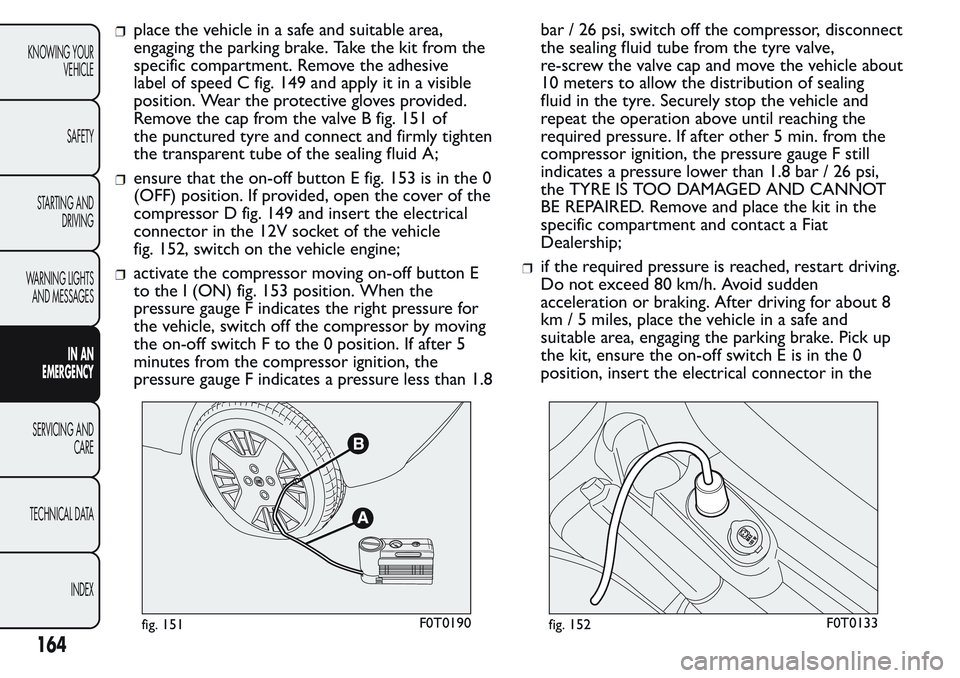
place the vehicle in a safe and suitable area,
engaging the parking brake. Take the kit from the
specific compartment. Remove the adhesive
label of speed C fig. 149 and apply it in a visible
position. Wear the protective gloves provided.
Remove the cap from the valve B fig. 151 of
the punctured tyre and connect and firmly tighten
the transparent tube of the sealing fluid A;
ensure that the on-off button E fig. 153 is in the 0
(OFF) position. If provided, open the cover of the
compressor D fig. 149 and insert the electrical
connector in the 12V socket of the vehicle
fig. 152, switch on the vehicle engine;
activate the compressor moving on-off button E
to the I (ON) fig. 153 position. When the
pressure gauge F indicates the right pressure for
the vehicle, switch off the compressor by moving
the on-off switch F to the 0 position. If after 5
minutes from the compressor ignition, the
pressure gauge F indicates a pressure less than 1.8bar / 26 psi, switch off the compressor, disconnect
the sealing fluid tube from the tyre valve,
re-screw the valve cap and move the vehicle about
10 meters to allow the distribution of sealing
fluid in the tyre. Securely stop the vehicle and
repeat the operation above until reaching the
required pressure. If after other 5 min. from the
compressor ignition, the pressure gauge F still
indicates a pressure lower than 1.8 bar / 26 psi,
the TYRE IS TOO DAMAGED AND CANNOT
BE REPAIRED. Remove and place the kit in the
specific compartment and contact a Fiat
Dealership;if the required pressure is reached, restart driving.
Do not exceed 80 km/h. Avoid sudden
acceleration or braking. After driving for about 8
km / 5 miles, place the vehicle in a safe and
suitable area, engaging the parking brake. Pick up
the kit, ensure the on-off switch E is in the 0
position, insert the electrical connector in the
fig. 151F0T0190fig. 152F0T0133
164
KNOWING YOUR
VEHICLE
SAFETY
STARTING AND
DRIVING
WARNING LIGHTS
AND MESSAGES
IN AN
EMERGENCY
SERVICING AND
CARE
TECHNICAL DATA
INDEX
Page 182 of 272
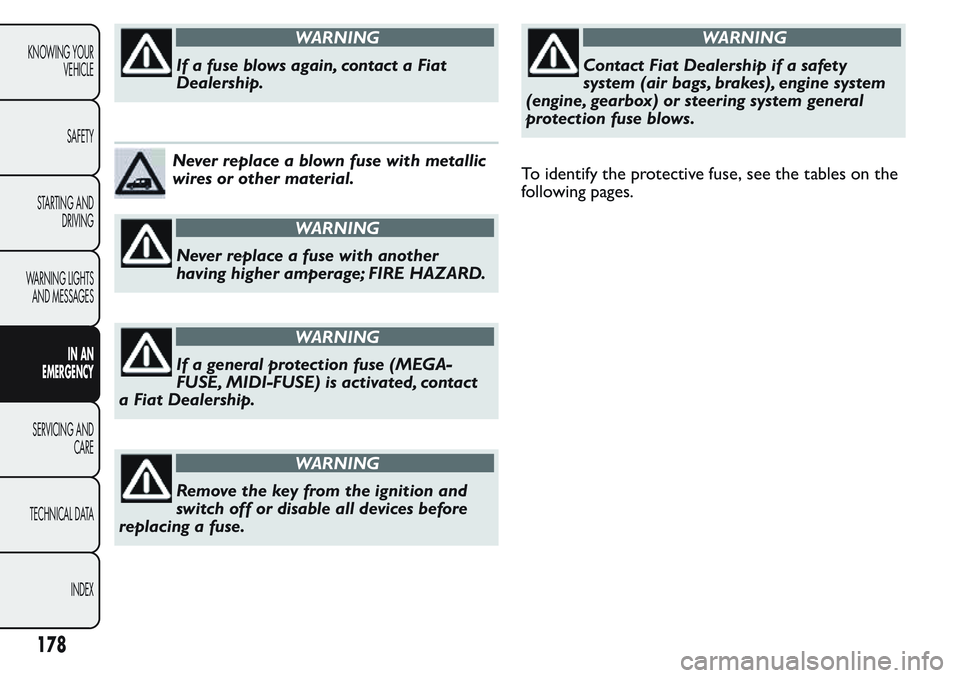
WARNING
If a fuse blows again, contact a Fiat
Dealership.
Never replace a blown fuse with metallic
wires or other material.
WARNING
Never replace a fuse with another
having higher amperage; FIRE HAZARD.
WARNING
If a general protection fuse (MEGA-
FUSE, MIDI-FUSE) is activated, contact
a Fiat Dealership.
WARNING
Remove the key from the ignition and
switch off or disable all devices before
replacing a fuse.
WARNING
Contact Fiat Dealership if a safety
system (air bags, brakes), engine system
(engine, gearbox) or steering system general
protection fuse blows.
To identify the protective fuse, see the tables on the
following pages.
178
KNOWING YOUR
VEHICLE
SAFETY
STARTING AND
DRIVING
WARNING LIGHTS
AND MESSAGES
IN AN
EMERGENCY
SERVICING AND
CARE
TECHNICAL DATA
INDEX
Page 183 of 272
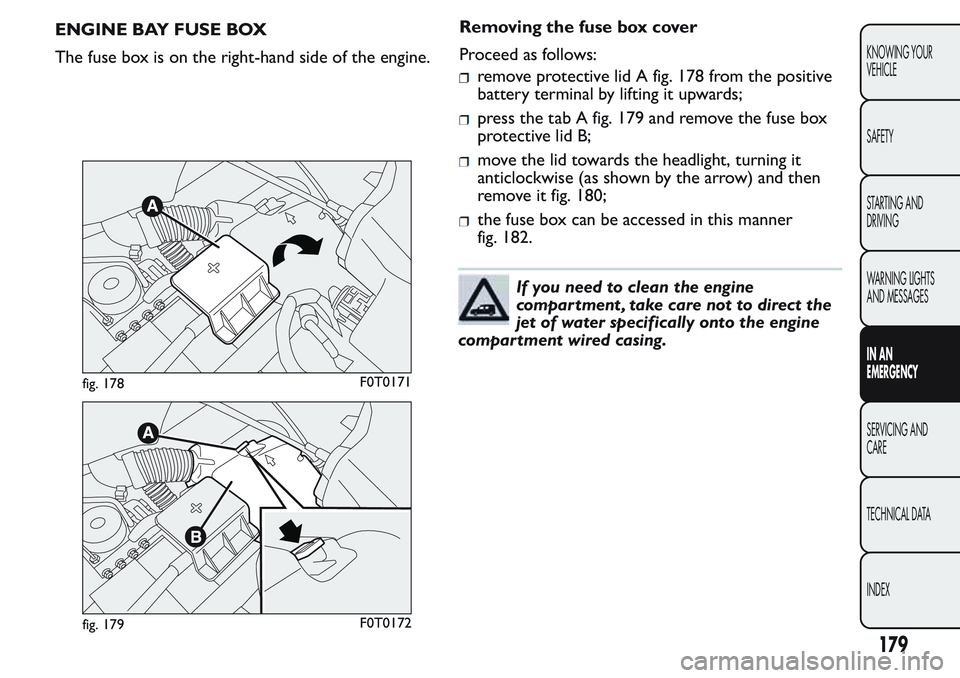
ENGINE BAY FUSE BOX
The fuse box is on the right-hand side of the engine.Removing the fuse box cover
Proceed as follows:
remove protective lid A fig. 178 from the positive
battery terminal by lifting it upwards;
press the tab A fig. 179 and remove the fuse box
protective lid B;
move the lid towards the headlight, turning it
anticlockwise (as shown by the arrow) and then
remove it fig. 180;
the fuse box can be accessed in this manner
fig. 182.
If you need to clean the engine
compartment , take care not to direct the
jet of water specifically onto the engine
compartment wired casing.
fig. 178F0T0171
fig. 179F0T0172
179
KNOWING YOUR
VEHICLE
SAFETY
STARTING AND
DRIVING
WARNING LIGHTS
AND MESSAGES
IN AN
EMERGENCY
SERVICING AND
CARE
TECHNICAL DATA
INDEX
Page 192 of 272
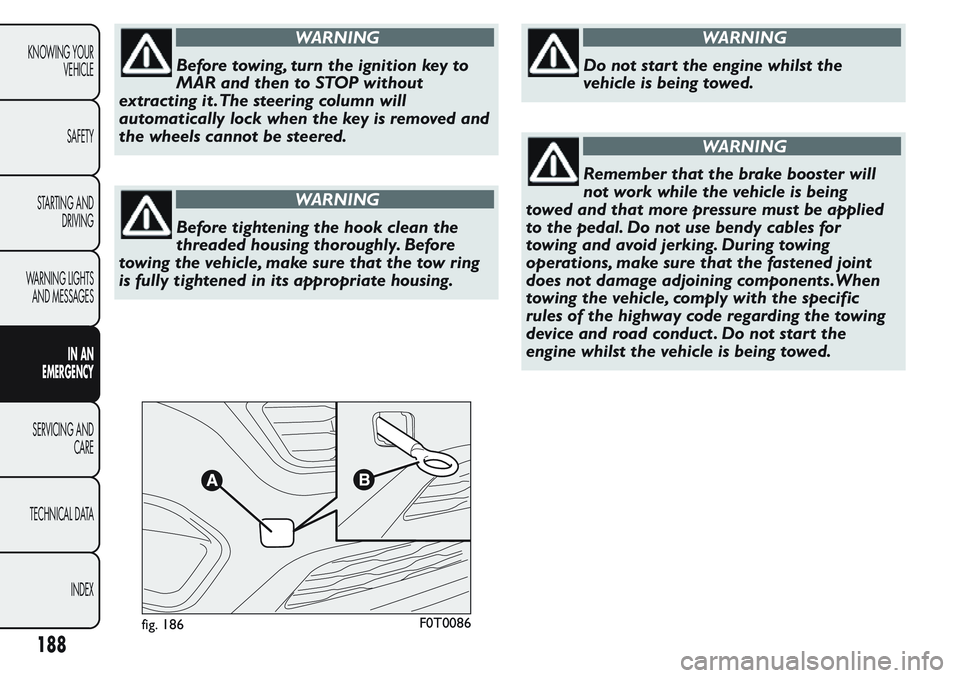
WARNING
Before towing, turn the ignition key to
MAR and then to STOP without
extracting it .The steering column will
automatically lock when the key is removed and
the wheels cannot be steered.
WARNING
Before tightening the hook clean the
threaded housing thoroughly. Before
towing the vehicle, make sure that the tow ring
is fully tightened in its appropriate housing.
WARNING
Do not start the engine whilst the
vehicle is being towed.
WARNING
Remember that the brake booster will
not work while the vehicle is being
towed and that more pressure must be applied
to the pedal. Do not use bendy cables for
towing and avoid jerking. During towing
operations, make sure that the fastened joint
does not damage adjoining components.When
towing the vehicle, comply with the specific
rules of the highway code regarding the towing
device and road conduct . Do not start the
engine whilst the vehicle is being towed.
fig. 186F0T0086
188
KNOWING YOUR
VEHICLE
SAFETY
STARTING AND
DRIVING
WARNING LIGHTS
AND MESSAGES
IN AN
EMERGENCY
SERVICING AND
CARE
TECHNICAL DATA
INDEX
Page 195 of 272
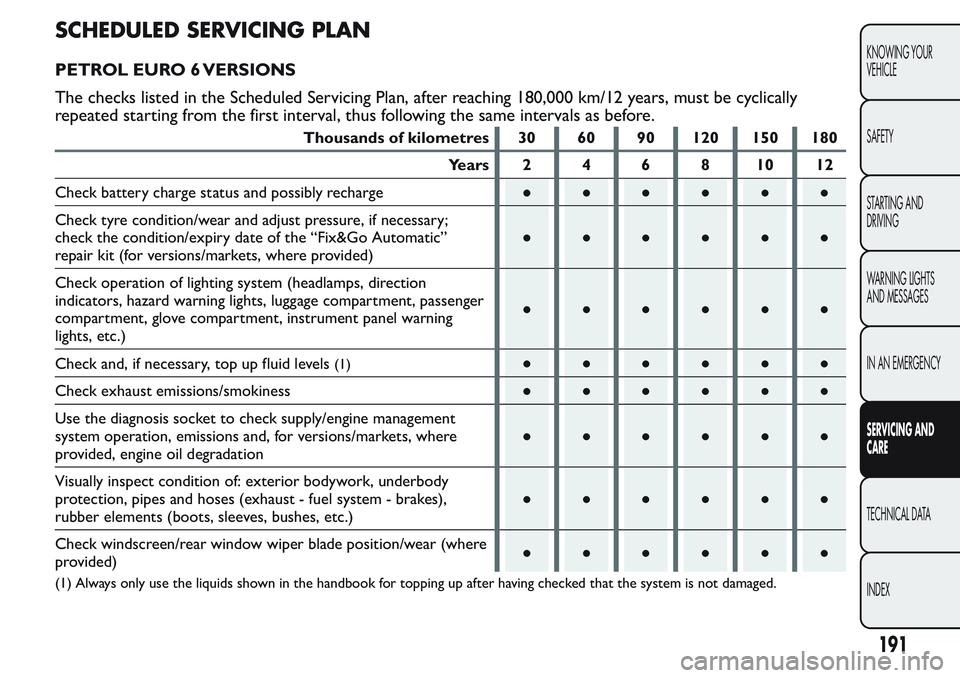
SCHEDULED SERVICING PLAN
PETROL EURO 6 VERSIONS
The checks listed in the Scheduled Servicing Plan, after reaching 180,000 km/12 years, must be cyclically
repeated starting from the first interval, thus following the same intervals as before.
Thousands of kilometres 30 60 90 120 150 180
Years 2 4 6 8 10 12
Check battery charge status and possibly recharge●●●●●●
Check tyre condition/wear and adjust pressure, if necessary;
check the condition/expiry date of the “Fix&Go Automatic”
repair kit (for versions/markets, where provided)●●●●●●
Check operation of lighting system (headlamps, direction
indicators, hazard warning lights, luggage compartment, passenger
compartment, glove compartment, instrument panel warning
lights, etc.)●●●●●●
Check and, if necessary, top up fluid levels
(1)●●●●●●
Check exhaust emissions/smokiness●●●●●●
Use the diagnosis socket to check supply/engine management
system operation, emissions and, for versions/markets, where
provided, engine oil degradation●●●●●●
Visually inspect condition of: exterior bodywork, underbody
protection, pipes and hoses (exhaust - fuel system - brakes),
rubber elements (boots, sleeves, bushes, etc.)●●●●●●
Check windscreen/rear window wiper blade position/wear (where
provided)●●●●●●
(1) Always only use the liquids shown in the handbook for topping up after having checked that the system is not damaged.
191
KNOWING YOUR
VEHICLE
SAFETY
STARTING AND
DRIVING
WARNING LIGHTS
AND MESSAGES
IN AN EMERGENCY
SERVICING AND
CARE
TECHNICAL DATA
INDEX
Page 196 of 272
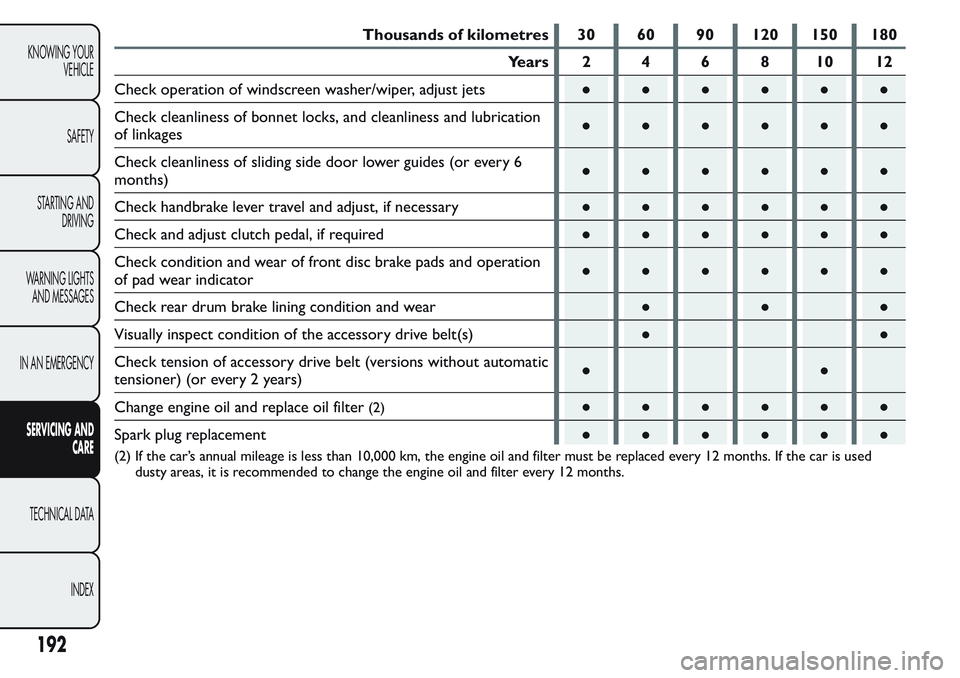
Thousands of kilometres 30 60 90 120 150 180
Years 2 4 6 8 10 12
Check operation of windscreen washer/wiper, adjust jets●●●●●●
Check cleanliness of bonnet locks, and cleanliness and lubrication
of linkages●●●●●●
Check cleanliness of sliding side door lower guides (or every 6
months)●●●●●●
Check handbrake lever travel and adjust, if necessary●●●●●●
Check and adjust clutch pedal, if required●●●●●●
Check condition and wear of front disc brake pads and operation
of pad wear indicator●●●●●●
Check rear drum brake lining condition and wear●●●
Visually inspect condition of the accessory drive belt(s)●●
Check tension of accessory drive belt (versions without automatic
tensioner) (or every 2 years)●●
Change engine oil and replace oil filter
(2)●●●●●●
Spark plug replacement●●●●●●
(2) If the car’s annual mileage is less than 10,000 km, the engine oil and filter must be replaced every 12 months. If the car is used
dusty areas, it is recommended to change the engine oil and filter every 12 months.
192
KNOWING YOUR
VEHICLE
SAFETY
STARTING AND
DRIVING
WARNING LIGHTS
AND MESSAGES
IN AN EMERGENCY
SERVICING AND
CARE
TECHNICAL DATA
INDEX
Page 198 of 272
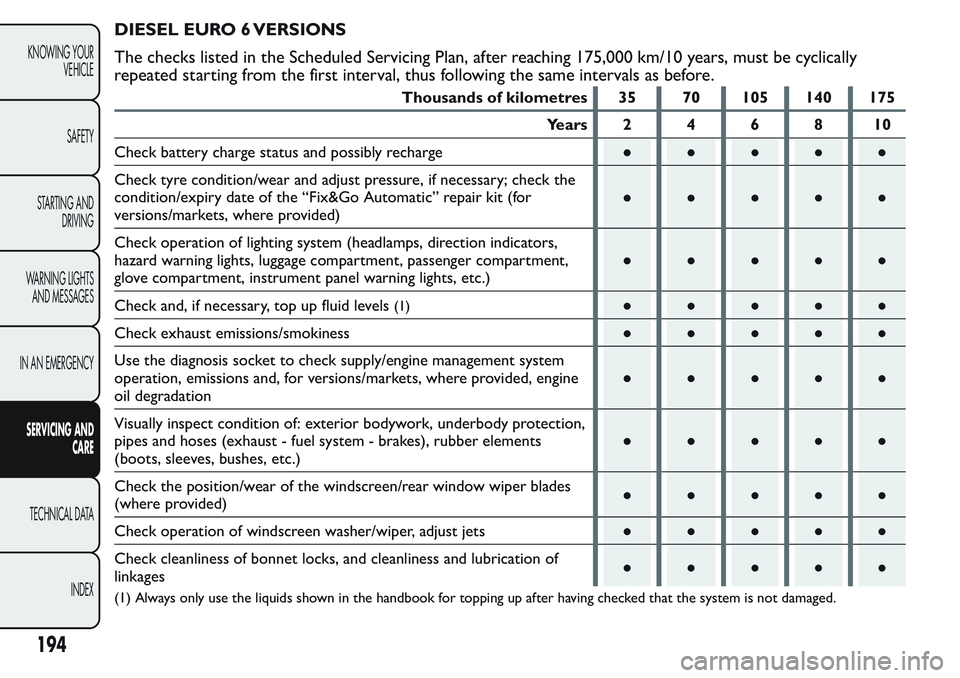
DIESEL EURO 6 VERSIONS
The checks listed in the Scheduled Servicing Plan, after reaching 175,000 km/10 years, must be cyclically
repeated starting from the first interval, thus following the same intervals as before.
Thousands of kilometres 35 70 105 140 175
Years 2 4 6 8 10
Check battery charge status and possibly recharge●●●●●
Check tyre condition/wear and adjust pressure, if necessary; check the
condition/expiry date of the “Fix&Go Automatic” repair kit (for
versions/markets, where provided)●●●●●
Check operation of lighting system (headlamps, direction indicators,
hazard warning lights, luggage compartment, passenger compartment,
glove compartment, instrument panel warning lights, etc.)●●●●●
Check and, if necessary, top up fluid levels
(1)●●●●●
Check exhaust emissions/smokiness●●●●●
Use the diagnosis socket to check supply/engine management system
operation, emissions and, for versions/markets, where provided, engine
oil degradation●●●●●
Visually inspect condition of: exterior bodywork, underbody protection,
pipes and hoses (exhaust - fuel system - brakes), rubber elements
(boots, sleeves, bushes, etc.)●●●●●
Check the position/wear of the windscreen/rear window wiper blades
(where provided)●●●●●
Check operation of windscreen washer/wiper, adjust jets●●●●●
Check cleanliness of bonnet locks, and cleanliness and lubrication of
linkages●●●●●
(1) Always only use the liquids shown in the handbook for topping up after having checked that the system is not damaged.
194
KNOWING YOUR
VEHICLE
SAFETY
STARTING AND
DRIVING
WARNING LIGHTS
AND MESSAGES
IN AN EMERGENCY
SERVICING AND
CARE
TECHNICAL DATA
INDEX
Page 199 of 272
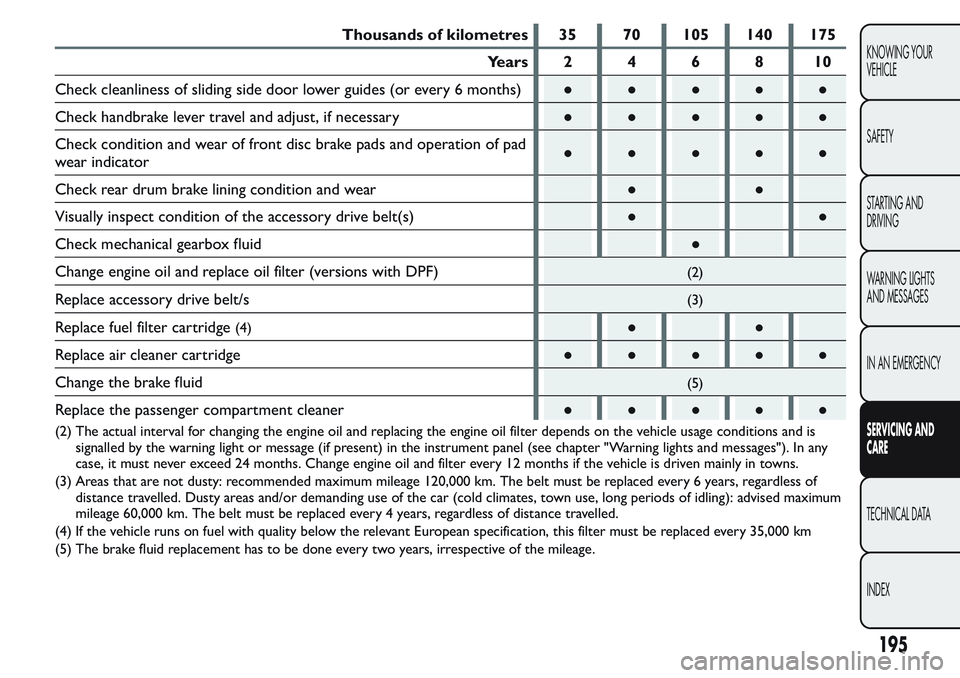
Thousands of kilometres 35 70 105 140 175
Years 2 4 6 8 10
Check cleanliness of sliding side door lower guides (or every 6 months)●●●●●
Check handbrake lever travel and adjust, if necessary●●●●●
Check condition and wear of front disc brake pads and operation of pad
wear indicator●●●●●
Check rear drum brake lining condition and wear●●
Visually inspect condition of the accessory drive belt(s)●●
Check mechanical gearbox fluid●
Change engine oil and replace oil filter (versions with DPF)
(2)
Replace accessory drive belt/s(3)
Replace fuel filter cartridge(4)●●
Replace air cleaner cartridge●●●●●
Change the brake fluid
(5)
Replace the passenger compartment cleaner●●●●●
(2) The actual interval for changing the engine oil and replacing the engine oil filter depends on the vehicle usage conditions and is
signalled by the warning light or message (if present) in the instrument panel (see chapter "Warning lights and messages"). In any
case, it must never exceed 24 months. Change engine oil and filter every 12 months if the vehicle is driven mainly in towns.
(3) Areas that are not dusty: recommended maximum mileage 120,000 km. The belt must be replaced every 6 years, regardless of
distance travelled. Dusty areas and/or demanding use of the car (cold climates, town use, long periods of idling): advised maximum
mileage 60,000 km. The belt must be replaced every 4 years, regardless of distance travelled.
(4) If the vehicle runs on fuel with quality below the relevant European specification, this filter must be replaced every 35,000 km
(5) The brake fluid replacement has to be done every two years, irrespective of the mileage.
195
KNOWING YOUR
VEHICLE
SAFETY
STARTING AND
DRIVING
WARNING LIGHTS
AND MESSAGES
IN AN EMERGENCY
SERVICING AND
CARE
TECHNICAL DATA
INDEX